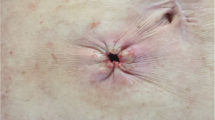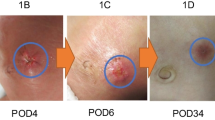Abstract
Aim
The PICO (Smith & Nephew, UK) dressing is a single use negative pressure wound therapy (NPWT) system that is designed to be used for up to 7 days for closed wounds. We aimed to assess its use for stoma closure wounds.
Method
We conducted a retrospective analysis of stoma reversal wounds from April 2018 to June 2019. The wound was partially closed with an absorbable subcutaneous suture in a purse-string fashion. A 15 cm × 15 cm PICO dressing was applied directly over this wound. A control group who had received partial purse string closure with packing over the same time period was identified. Patients were contacted and information collected using a questionnaire. The primary outcome measure was the number of visits for dressing changes in the community. Further information was collected about length of stay, time to resolution of pain and return to work.
Results
On average, the patients with PICO dressings attended the community nurses 1.9 times. The patients in the PICO group stated it took 1–2 weeks to return to full work/daily activities. The control group averaged attending the community nurse 11.9 times, and 33% had not returned to work/daily activities in 1–2 weeks.
Conclusion
Those who had a PICO dressing required fewer visits to the community nurse and the majority were able to return to work or resume usual activities within 1 to 2 weeks. This pilot study suggests that negative pressure dressings may be a useful aid for stoma closure site wounds.
Similar content being viewed by others
References
Miller C (2013) The history of negative pressure wound therapy (NPWT): from “Lip Service” to the modern vacuum system. J Am Coll Clin Wound Spec 4(3):61–62
Kim S, Kang SI (2020) The effectivness of negative-pressure wound therapy for wound healing after stoma reversal: a randomised control study (SR-PICO study). Trials 22–24
Lee T, Marquez TT, Clerc D, Gie O, Demartines N, Madoff RD et al (2014) Pursestring closure of the stoma site leads to fewer wound infections: results from a multicenter randomized controlled trial. Dis Colon Rectum 57:1282–1289
Camacho-Mauries D, Rodriguez-Diaz JL, Salgado-Nesme N, Gonzalez QH, Vergara-Fernandez O (2013) Randomized clinical trial of intestinal ostomy takedown comparing pursestring wound closure vs conventional closure to eliminate the risk of wound infection. Dis Colon Rectum 56:205–211
Smith and Newphw (2018) Smith-Newphw.com. 15 April 2020. 1. https://www.smith-nephew.com/key-products/advanced-wound-management/pico/pico-7/
National Institute for Health and Care Excellence (2019) NICE.org.uk. 5 April 2020. 1. https://www.nice.org.uk/guidance/mtg43/resources/pico-negative-pressure-wound-dressings-for-closed-surgical-incisions-pdf-64372054098373
Dindo D, Demartines N, Clavien PA (2004) Classification of surgical complications a new proposal with evaluation in a cohort of 6336 patients and results of a survey. Ann Surg 240(2):205–213
Morykwas MJ, Argenta LC (1997) Classification of surgical complications a new proposal with evaluation in a cohort of 6336 patients and results of a survey. Ann Plast Surg 38(6):563–577
Sinha K, Chauhan VD, Maheshwari R, Chauhan N, Rajan M, Agrawal A (2013) Vacuum assisted closure therapy versus standard wound therapy for open musculoskeletal injuries. Adv Orthop 2013:245940
Malmsjö M, Huddleston E, Martin R (2014) “Biological effects of a disposable, canisterless negative pressure wound therapy system.” Malmsjö M, Huddleston E, Martin R. Biological effects of a disposable, canisterless negative pressure wound therapy system. Eplasty 14:e15 Published 2014 Apr 2. 14 (2014): 15
Karlakki S, Brem M, Giannini S, Khanduja V, Stannard J, Martin R (2013) Negative pressure wound therapy for management of the surgical incision in orthopaedic surgery: a review of evidence and mechanisms for an emerging indication. Bone Joint Res 2(12):276–284
O'Leary DP, Peirce C, Anglim B, Burton M, Concannon E, Carter M, Hickey K, Coffey JC (2017) Prophylactic negative pressure dressing use in closed laparotomy wounds following abdominal operations: a randomized, controlled, open-label trial: the P.I.C.O. trial. Ann Surg 2017(265):1082–1086
Huang C, Leavitt T, Bayer LR, Orgill DP (2014) Effect of negative pressure wound therapy on wound healing. Curr Probl Surg 51:301–331
Cantero R, Rubio-Perez I, Leon M, Alvarez M, Diaz B, Herrera A, Diaz-Dominguez J, Rodriguez-Montes JA (2016) Negative-pressure therapy to reduce the risk of wound infection following diverting loop ileostomy reversal: an initial study. Adv Skin Wound Care 29:114–118
Poehnert D, Hadeler N, Schrem H, Kaltenborn A, Klempnauer J, Winny M (2017) Decreased superficial surgical site infections, shortened hospital stay, and improved quality of life due to incisional negative pressure wound therapy after reversal of double loop ileostomy. Wound Repair Regen 25(6):994–1001
van der Valk M, de Graaf E, Doornebosch P, Vermaas M (2017) Incisional negative-pressure wound therapy for perineal wounds after abdominoperineal resection for rectal cancer, a pilot study. Adv Wound Care 6:425–429
Rondelli F, Franco L, Balzarotti Canger RC, Ceccarelli G, Becattini C, Bugiantella W (2018) Purse-string closure versus conventional primary closure of wound following stoma reversal: meta-analysis of randomized controlled trials. Int J Surg 52:208–213
Hajibandeh S, Hajibandeh S, Kennedy-Dalby A, Rehman S, Zadeh RA (2018) Purse-string skin closure versus linear skin closure techniques in stoma closure: a comprehensive meta-analysis with trial sequential analysis of randomised trials. Int J Color Dis 33(10):1319–1332
Goodman C, Daves SL, Gordon AL, et al (2017) Health services and delivery research: optimal NHS service delivery to care homes: a realist evaluation of the features and mechanisms that support effective working for the continuing care of older people in residential settings. NIHR J Libr
Griffths B, Pagnamenta F, Clark M (2020) Prevena incision managment system for closed surgical incisions.” 28 Februrary 2019. Natl Instit Health and Care Excell
McCluskey P, Brennan K, Mullan J, Costello M, McDonagh D, Meagher H, McLoughlin G, Moloney H, Styche T, Murdoch J (2020) Impact of a single-use negative pressure wound therapy system on healing. J Commun Nurs 34:1
Author information
Authors and Affiliations
Corresponding author
Ethics declarations
Conflicts of interest
The authors declare that they have no conflict of interest.
Ethics approval
Not applicable
Consent to participate
Not applicable
Consent for publication
Not applicable
Code availability
Not applicable
Additional information
Publisher’s note
Springer Nature remains neutral with regard to jurisdictional claims in published maps and institutional affiliations.
What does this paper add to the existing literature?
It suggests that negative pressure dressings may be a useful aid for stoma closure site wounds. This has not been documented in the literature.
Appendix
Appendix
Rights and permissions
About this article
Cite this article
Obeid, N., Sharma, E., Dunstan, M. et al. Negative pressure therapy for stoma closure sites—a nonrandomised case control study. Int J Colorectal Dis 36, 161–167 (2021). https://doi.org/10.1007/s00384-020-03749-x
Accepted:
Published:
Issue Date:
DOI: https://doi.org/10.1007/s00384-020-03749-x








